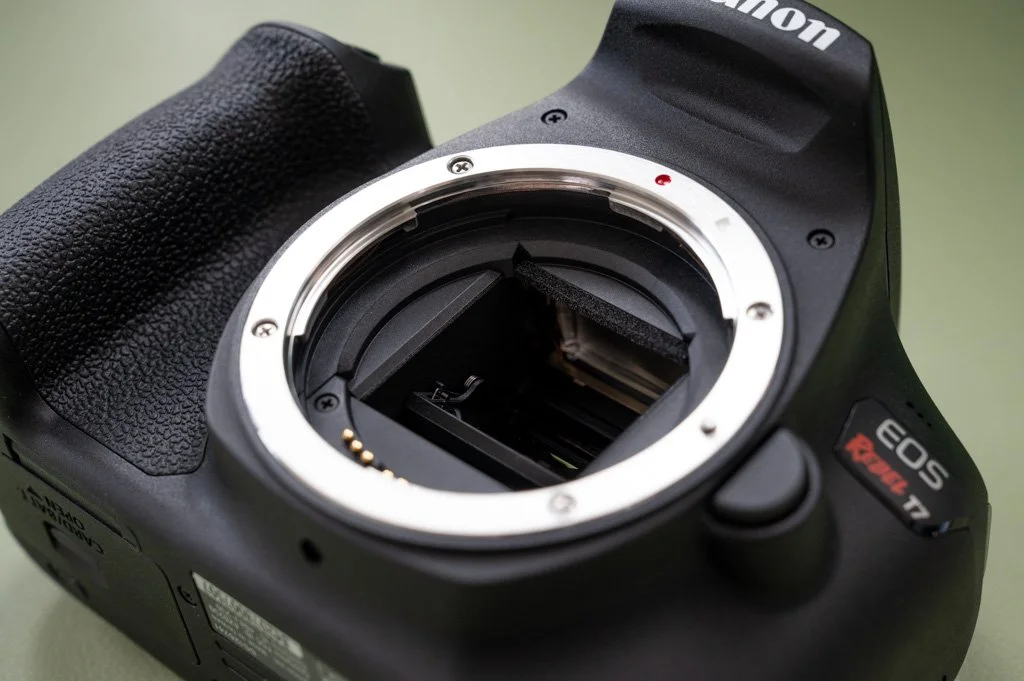Canon EOS Rebel T7 Review (2025): The Perfect First Camera for Beginners
Rating: ★★★★☆ (4/5 Stars)
This is probably your last opportunity to get an entry-level DSLR before they’re all replaced with mirrorless cameras (and whatever replaces mirrorless cameras). The Canon EOS Rebel T7 (also known as the Kiss X90 in Japan or EOS 1500D in Europe) is a beginner DSLR aimed squarely at those who want to learn photography without spending a fortune. It’s not a new camera. In fact, it’s a fairly old camera that was first released by Canon in 2018. Yet whether you're a student, a parent looking to capture family moments, or someone stepping up from a smartphone in 2025, the EOS Rebel T7 offers a traditional camera experience with just enough manual control to grow your skills.
It's also an easy recommendation for anyone who wants to explore the DSLR ecosystem; meaning interchangeable lenses, optical viewfinder, and solid battery life without jumping into mirrorless prices. For just over $400, you can get a truly great photo taking camera.
That said, if you're looking for speed, 4K video, or more modern conveniences like a tilting touchscreen, you'll want to look elsewhere. This camera is all about the basics and for many people, that's more than enough.
Here’s my review of the Canon EOS Rebel T7 for amateur photographers in 2025.
Canon EOS Rebel T7 Specifications
| Sensor | 24.1MP APS-C CMOS |
| Image Processor | DIGIC 4+ |
| ISO Range | 100–6400 (expandable to 12800) |
| Autofocus System | 9-point AF (center cross-type) |
| Continuous Shooting | 3 fps |
| Viewfinder | Optical (95% coverage, 0.80x magnification) |
| Screen | 3.0" LCD, 920k dots (fixed, non-touch) |
| Video Resolution | 1080p at 30/25/24 fps |
| Image Format | JPEG, RAW (CR2) |
| Lens Mount | Canon EF/EF-S |
| Kit Lens | 18–55mm f/3.5–5.6 IS II (included in most bundles) |
| Battery Life | ~500 shots per charge (CIPA) |
| Connectivity | Wi-Fi, NFC |
| Weight | ~475g (with battery and card) |
| Released | 2018 |
| 🛒 Price | Check on Amazon |
Unboxing the EOS Rebel T7: What’s it like to use?
Using the Canon Rebel T7 is like stepping back to the core of photography. It has no frills, which makes it refreshingly straightforward. I felt like I had everything I needed in finger’s reach, meaning the on/off switch, mode dial, selector wheel, and live-view button were all placed conveniently and ergonomically where I needed them.
I’ll be honest here, I have shot primarily with Nikon cameras since about 2005, so Canon has always felt slightly uncomfortable to me. For one, the zoom on their lenses turns the “wrong” way. And the aperture and shutter speed selection never felt particularly intuitive. The EOS Rebel T7 actually made me enjoy shooting a Canon camera, which is saying something.
Bottom line: the grip is comfortable, the physical buttons are clearly labeled and accessible, and the mode dial gives you full access to manual controls if you want them.
Speaking of basics, you’ll find that the rear screen, while bright and large, is fixed and non-touch, which can feel dated, especially if you're used to modern mirrorless cameras or smartphones. It took me a while to stop putting my fingerprints on the screen… I kept trying to select settings on the monitor. But for framing through the viewfinder and navigating menus, it gets the job done. When you’re shooting, the display shows you camera settings. If you want to use the display instead of the viewfinder, there’s a handy button right next to that viewfinder (which also doubles as a record button).
I’m telling you, the user interface is beginner-friendly, and Canon’s in-camera guide helps walk you through common settings that you might not be aware of.
Autofocus is basic with just 9 points using contrast detection, but it’s reliable in good lighting. And while you probably won’t be tracking fast action with this camera, it’s great for still portraits, landscapes, or products.
Image quality
The EOS Rebel T7's 24.1MP APS-C sensor is its best asset. In good light, it gives you sharp, colorful images with that classic Canon color science. I read that skin tones are flattering (but I didn’t take any portraits with this camera… yet) and JPEGs straight out of camera are ready to post or print with minimal editing.
You can shoot in RAW (CR2) for more flexibility in post-processing, and dynamic range is decent, though not exceptional. ISO performance is acceptable up to around ISO 1600–3200 for casual use. If you decide to push it further, you'll start to see noticeable noise and loss of detail.
For hobbyist photographers who care more about capturing memories than pixel peeping, the image quality is more than satisfactory. That doesn’t sound like a compliment, but it is. You can check out some casual sample photos below to see what it can do. I took them on an hour long lunch walk, and on a weekend morning.
Video quality
You might be disappointed here because the EOS Rebel T7 shows its age (seven, by the way, which is old for a digital camera) when it comes to video. It maxes out at 1080p (Full HD, 1920x1080) video, with no 4K and no Dual Pixel autofocus. You see, the Rebel T7 relies on contrast autofocus which you can tell is happening when the lens focuses in and out, kind of like a guess and check, to measure the distance of the subject. Canon has a fancy Dual Pixel autofocus which makes focusing fast and easy, yet is not present in this camera (but does exist in the $700 mirrorless Canon EOS R50).
There’s also no mic input, flip screen (I said this already), or image stabilization for video. It’s not meant to be a vlogging camera or a video workhorse. If your content creation leans heavily on video, the T7 isn’t your best bet.
That’s not to say that it doesn’t do a great job with what it’s got. If you just want to film short clips, school projects, or basic family footage, the quality is acceptable, especially on a tripod in controlled lighting.
Lens Compatibility: EF and EF-S Mount
One of the big advantages of the Rebel T7 is its access to Canon’s huge selection of EF and EF-S lenses. That means even though this camera is budget-friendly, it can grow with you. The camera usually comes with a very standard and admirable Canon EF-S 18-55mm f/3.5-5.6 IS II lens ($200 on its own!), but there are many other options to choose from, both from Canon and third-party providers like Sigma.
A few great starter lenses to consider:
Canon 50mm f/1.8 STM – A sharp, affordable prime for portraits and low light
Canon 55–250mm f/4–5.6 IS STM – Lightweight telephoto for wildlife or sports
Sigma 17–50mm f/2.8 EX DC OS HSM – A brighter alternative to the kit zoom
If you're buying used, check for EF lenses with image stabilization since they’ll help offset the lack of IBIS in the T7.
How It Compares to the Canon Rebel T6
The Rebel T7 is essentially a refreshed version of the T6 which was released in 2016, with its most notable upgrade being the jump to a 24.1MP sensor (up from 18MP). Other specs remain mostly the same, so if you’re coming from a T6, the improvement is mainly in image resolution and a slightly newer image processor.
Still, it’s a better buy today thanks to broader software compatibility, Wi-Fi sharing, and support for newer SD cards.
Limitations
As with any camera, there are limitations. No camera is perfect, and chasing perfection has a name: Gear Acquisition Syndrome. Here’s what I found to be the Rebel T7’s biggest drawbacks.
Outdated features: No 4K video, no touchscreen, no in-body stabilization.
Slow burst rate: 3 fps continuous shooting is too slow for action.
Autofocus limitations: Only 9 AF points and no modern subject tracking; contrast autofocus.
Fixed rear screen: Not ideal for video creators or selfie shooters.
Basic build quality: Entirely plastic body with no weather sealing.
Keep in mind that this camera is seven years old and you’re likely not looking at it because of its bells and whistles. You’re looking at it for the price and what it can do at that price point. Hard to judge a camera based on a lack of features that weren’t very standard at the time. There are cameras coming out today that are even worse, if you can believe it.
None of these are deal-breakers if your needs are basic. But they do put the T7 at a disadvantage compared to newer, mirrorless alternatives like the Canon EOS R100 (which I loved) or even the Nikon Z30.
Sample Images from the Canon EOS Rebel T7
Here are a few sample photos taken with the Canon EOS Rebel T7 using the standard 18–55mm kit lens. You can see that, despite its entry-level positioning, the EOS Rebel T7’s 24.1MP sensor is capable of clean, detailed JPEGs when paired with decent lighting and the right lens. Even if that right lens is the one the camera came with.
Shooting RAW on the Rebel T7: Why You Should Try It
One of the best things about stepping up from a smartphone to a DSLR like the Canon EOS Rebel T7 is the ability to shoot in RAW. Unlike JPEGs, which are processed and compressed in-camera, RAW files preserve all the image data from the sensor giving you more flexibility in editing.
The T7 captures RAW files using Canon’s CR2 (Canon Raw 2nd edition) format. These files are larger than JPEGs and can’t be opened natively in every photo viewer, but they shine when processed in tools like Lightroom, Photoshop, or Canon’s own Digital Photo Professional (which is free).
Why shoot RAW?
Recover details from shadows or highlights
Fine-tune white balance after the shot
Avoid compression artifacts
Get better results from color grading
For beginners, RAW might sound intimidating, but even just experimenting with it will help you understand exposure, dynamic range, and how much control you really have over your images. The T7 also supports RAW + JPEG mode (photo above), which lets you keep both versions, so you can grow into RAW without giving up the quick convenience of JPEGs. Just keep in mind that the photos take up a lot of space on a memory card.
Recommended Accessories for Beginners
If you’re picking up the T7 for the first time, here are a few low-cost accessories to round out your kit:
💾 64GB SD Card (UHS-I) ($15)– You’ll need this for storing RAWs and video
🔋 Extra LP-E10 Batteries ($20) – The battery life is decent, but a backup helps on long outings
📷 Tripod ($28) – Helps with sharp shots in low light
👜 Camera Bag or Sling ($25) – Keeps your gear protected and organized
Final thoughts
The Canon EOS Rebel T7 may be several years old now, but it continues to be one of the most popular beginner DSLRs for a reason: it’s simple, affordable, and produces reliably good images. If you can find it bundled with the 18–55mm kit lens for under $500, it’s still a solid deal in 2025. In fact, Amazon usually has them on sale for just over $400.
For anyone who wants to dip their toes into DSLR photography, especially on a tight budget, the Rebel T7 is a sensible starting point. It won’t win any speed races, and it lacks modern flair, but it delivers where it counts: in the photos.
































